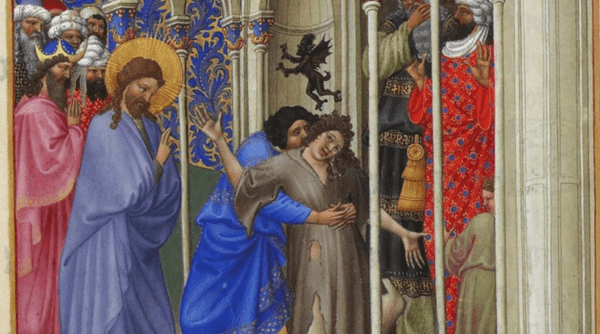The Synoptic Gospels present Jesus as a teacher, healer, and exorcist. He was not very unusual in that. There were other charismatic healers and exorcists at the time. There was, however, something very unusual in the way Jesus did exorcisms. We can best see this in His first public miracle in the Gospel of Mark (1:21–28), which started His ministry and created His fame, not because He had exorcised a man, but because of how He did it:
Then they came to Capernaum, and on the sabbath he entered the synagogue and taught. The people were astonished at his teaching, for he taught them as one having authority and not as the scribes. In their synagogue was a man with an unclean spirit; he cried out, “What have you to do with us, Jesus of Nazareth? Have you come to destroy us? I know who you are—the Holy One of God!” Jesus rebuked him and said, “Quiet! Come out of him!” The unclean spirit convulsed him and with a loud cry came out of him. All were amazed and asked one another, “What is this? A new teaching with authority. He commands even the unclean spirits and they obey him.” His fame spread everywhere throughout the whole region of Galilee.
The demon in this case seems to have reacted to the presence of Jesus, which initiated the encounter. Here we see no use of roots or smells, no invoking of names, no incantations, no quoting of Scripture, and not even prayer. Jesus simply said, “Come out of him!”
The people were amazed by a few things about this exorcism. First, at the way Jesus did the exorcism: that He had inherent power in Himself alone. Secondly, that the demon recognized His power to destroy them, and said that Jesus was the Holy One of God. Jesus also had no need to tell the demon not to return, and He sought no display for the people; if anything, He told the demon to be quiet.Later, Jesus entered the territory of the Gerasenes on the eastern shore of the Sea of Galilee. This was a mostly Gentile region inhabited by Greek settlers. The story is in Mark 5:1–20:
They came to the other side of the sea, to the territory of the Gerasenes. When he got out of the boat, at once, a man from the tombs who had an unclean spirit met him. The man had been dwelling among the tombs, and no one could restrain him any longer, even with a chain. In fact, he had frequently been bound with shackles and chains, but the chains had been pulled apart by him and the shackles smashed, and no one was strong enough to subdue him. Night and day among the tombs and on the hillsides he was always crying out and bruising himself with stones. Catching sight of Jesus from a distance, he ran up and prostrated himself before him, crying out in a loud voice, “What have you to do with me, Jesus, Son of the Most High God? I adjure you by God, do not torment me!” (He had been saying to him, “Unclean spirit, come out of the man!”) He asked him, “What is your name?” He replied, “Legion is my name. There are many of us. And he pleaded earnestly with him not to drive them away from that territory. Now a large herd of swine was feeding there on the hillside. And they pleaded with him, “Send us into the swine. Let us enter them.” And he let them, and the unclean spirits came out and entered the swine. The herd of about two thousand rushed down a steep bank into the sea, where they were drowned. The swineherds ran away and reported the incident in the town and throughout the countryside. And people came out to see what had happened. As they approached Jesus, they caught sight of the man who had been possessed by Legion, sitting there clothed and in his right mind. And they were seized with fear. Those who witnessed the incident explained to them what had happened to the possessed man and to the swine. Then they began to beg him to leave their district. As he was getting into the boat, the man who had been possessed pleaded to remain with him. But he would not permit him but told him instead, “Go home to your family and announce to them all that the Lord in his pity has done for you.” Then the man went off and began to proclaim in the Decapolis what Jesus had done for him; and all were amazed.
First, we see some similarities to the synagogue in Capernaum: the demon is agitated by the presence of Jesus, and it identifies Jesus’ true nature. We also see a critical difference: Jesus had been telling the demon to come out, but the demon seems to have resisted, and said, “I adjure you by God, do not torment me!” Jesus then asks the demon’s name, a critical addition to the exorcism. Within the Jewish understanding, to surrender your name is the same as surrendering yourself. Jesus, as God, already knew the name of the demon and had complete power over it; the critical action was the demon being forced to openly surrender that power to Jesus. That was a sign of submission. The final action, Jesus allowing them to enter the swine, was not unheard of. The idea that demons could be transferred from a person to another object was not unusual to the Jews at the time. It was not unusual for exorcists of the time to exorcise people from a distance. In Mark 7:24–30, we see Jesus responding to a Gentile mother of a daughter who was possessed:
From that place he went off to the district of Tyre. He entered a house and wanted no one to know about it, but he could not escape notice. Soon a woman whose daughter had an unclean spirit heard about him. She came and fell at his feet. The woman was a Greek, a Syrophoenician by birth, and she begged him to drive the demon out of her daughter. He said to her, “Let the children be fed first. For it is not right to take the food of the children and throw it to the dogs.” She replied and said to him, “Lord, even the dogs under the table eat the children’s scraps.” Then he said to her, “For saying this, you may go. The demon has gone out of your daughter.” When the woman went home, she found the child lying in bed and the demon gone.
In this instance, Jesus models the power of prayer, in this case directed to him, to liberate people. No apparent action is needed at all in this case: Jesus merely tells her that it is already done. Clearly, this is an even greater departure from the normative model of exorcism at the time.
Finally, we consider the case of the epileptic boy in Mark 9:17–29, which contains new insights into Jesus’ exorcisms:
Someone from the crowd answered him, “Teacher, I have brought to you my son possessed by a mute spirit. Wherever it seizes him, it throws him down; he foams at the mouth, grinds his teeth, and becomes rigid. I asked your disciples to drive it out, but they were unable to do so.” He said to them in reply, “O faithless generation, how long will I be with you? How long will I endure you? Bring him to me.” They brought the boy to him. And when he saw him, the spirit immediately threw the boy into convulsions. As he fell to the ground, he began to roll around and foam at the mouth. Then he questioned his father, “How long has this been happening to him?” He replied, “Since childhood. It has often thrown him into fire and into water to kill him. But if you can do anything, have compassion on us and help us.” Jesus said to him, “‘If you can!’ Everything is possible to one who has faith.” Then the boy’s father cried out, “I do believe, help my unbelief!” Jesus, on seeing a crowd rapidly gathering, rebuked the unclean spirit and said to it, “Mute and deaf spirit, I command you: come out of him and never enter him again!” Shouting and throwing the boy into convulsions, it came out. He became like a corpse, which caused many to say, “He is dead!” But Jesus took him by the hand, raised him, and he stood up. When he entered the house, his disciples asked him in private, “Why could we not drive it out?” He said to them, “This kind can only come out through prayer.”
Jesus’ disciples were unable to drive this demon out. Jesus then complains of a lack of faith, but it is not yet clear if it is on the part of the father or His disciples. When the boy is presented to Jesus the father asks if Jesus can do anything, and then we see that Jesus was referring to the father. The father then prays, “I do believe, help my unbelief!” Jesus seems to accept this as adequate on the father’s part, so He casts the demon out. Later, when Jesus was with His disciples in private, they asked Him why they could not cast it out. Strangely, He does not reference the father’s lack of faith, but their lack of prayer. The variant for this final line is “This kind can only come out through prayer and through fasting.”
Here, we see Jesus teaching the people about the importance of faith, and His disciples about the importance of prayer and fasting, in exorcism. Jesus needs nothing, and in the case of the woman’s daughter, need do nothing at all to perform exorcisms. The people and His disciples need to rely on their faith and relationship with God, which is strengthened through prayer and fasting.
The exorcisms of Jesus had new and unprecedented features that the Jewish authorities could not accept. The scribes concluded that His apparent power had to come from Him being in league with Beelzebul, the ruler of the demons. In Luke 11:19–20, Jesus made a critical proclamation about both Himself and the meaning of His exorcistic work:
If I, then, drive out demons by Beelzebul, by whom do your own people drive them out? Therefore they will be your judges. But if it is by the finger of God that [I] drive out demons, then the kingdom of God has come upon you.
Jesus claimed that His exorcisms were manifestations of the Kingdom of God, and were “nothing less than the cosmic plan of God by which he was regaining control over an estranged and hostile creation, which was under subjection to the powers
of Satan.”
Jesus performed many exorcisms as part of His public ministry. These were signs of His divine power, as He had, in himself, full power over demons. He had no need of any object, name, incantation, or prayer, like the other exorcists of His time. Jesus also explicitly empowered His twelve disciples with authority over demons in all of the Synoptic Gospels:
Then he summoned his twelve disciples and gave them authority over unclean spirits to drive them out and to cure every disease and every illness. (Matt. 10:1)
He summoned the Twelve and began to send them out two by two and gave them authority over unclean spirits. (Mark 6:7)
He summoned the Twelve and gave them power and authority over all demons and to cure diseases. (Luke 9:1)
Finally, when Jesus commissioned His twelve disciples to go and do their work, He explicitly included the exercise of that authority over demons:
As you go, make this proclamation: “The kingdom of heaven is at hand.” Cure the sick, raise the dead, cleanse lepers, drive out demons. (Matt. 10:7–8)
Many Protestant Christians claim that Jesus gave power over demons to all Christians based on Luke 10:17–20:
The seventy[-two] returned rejoicing, and said, “Lord, even the demons are subject to us because of your name.” Jesus said, “I have observed Satan fall like lightning from the sky. Behold, I have given you the power ‘to tread upon serpents’ and scorpions and upon the full force of the enemy and nothing will harm you. Nevertheless, do not rejoice because the spirits are subject to you, but rejoice because your names are written in heaven.”
Whether all Christians, some Christians, or only priests and bishops have authority to cast out demons would be revealed in time. Many centuries of experience would give the Church the wisdom to limit the exercise of the sacramental of exorcism and codify that limit into law. We now turn to that development.
+
This article is adapted from the book The History of Exorcism by Adam Blai which is available from Sophia Institute Press.
Art for this post on a reflection from “The History of Exorcism” by Adam Blai: Cover image used with permission; Featured image Detail of Les Très Riches Heures du duc de Berry, Folio 166r – The Exorcism the Musée Condé, Chantilly. {{PD-art}}






